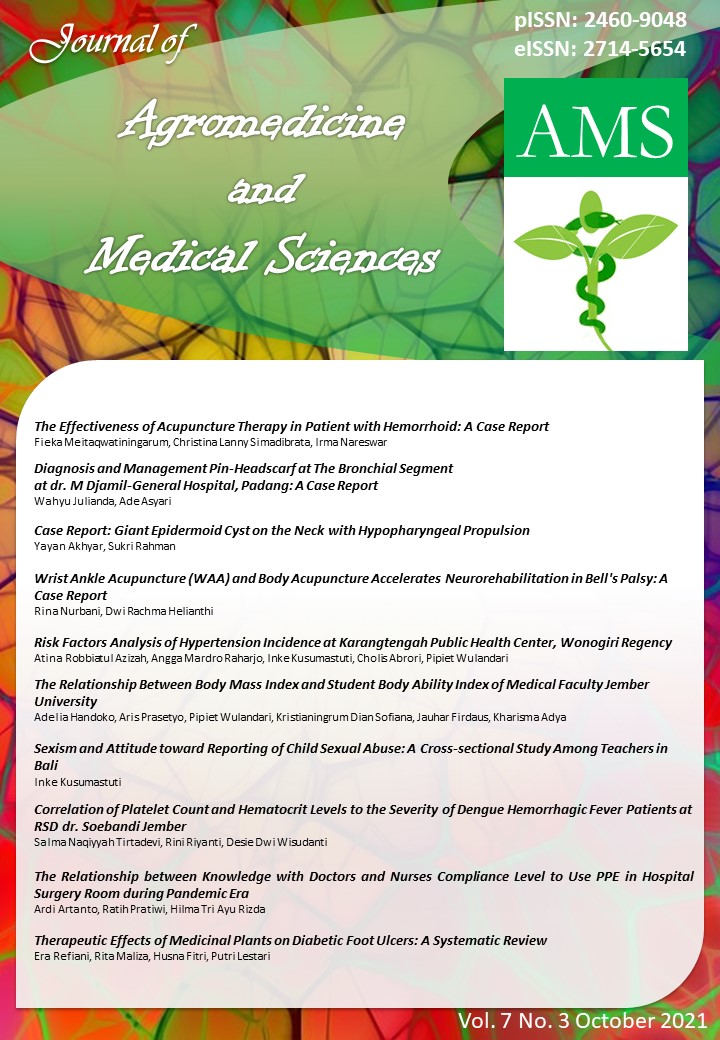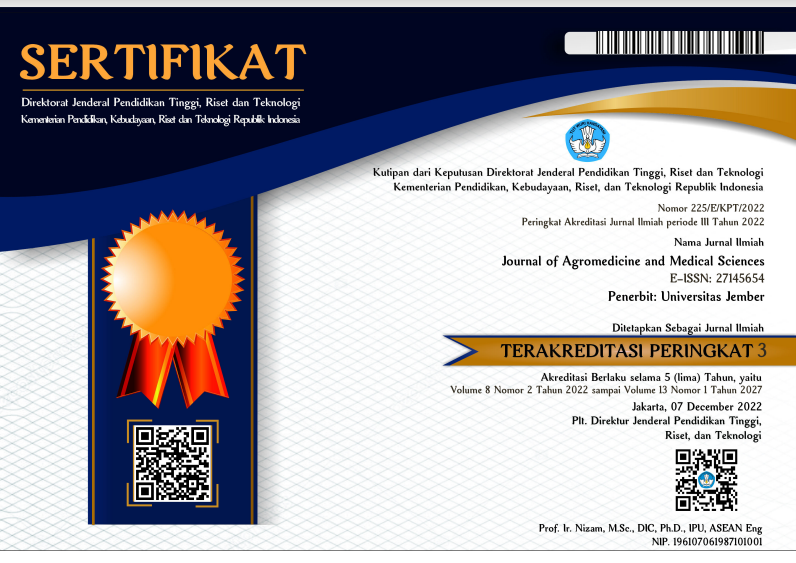Correlation of Platelet Count and Hematocrit Levels to the Severity of Dengue Hemmoraghic Fever Patients at RSD dr. Soebandi Jember
DOI:
https://doi.org/10.19184/ams.v7i3.24362Abstract
Dengue hemorraghic fever (DHF) is an infectious disease caused by the dengue virus and It is still be a major health problem in Southeast Asia, especially in Indonesia. Kabupaten Jember is still categorized as a dengue endemic area with its disease development expanding from year to year. This study aims to determine the correlation of platelet count and hematocrit levels to the severity of DHF patients at RSD dr. Soebandi Jember, as well as knowing whether the platelet count and hematocrit levels can be used as a predictive value for the severity of DHF patients at RSD dr. Soebandi Jember. This study used an observational analytic study with a cross-sectional study design. The data of this study used secondary data from the medical records of DHF patients at RSD dr. Soebandi Jember. The results of this study with a total of 68 samples showed that there was a significant negative correlation between the platelet count to the severity of DHF patients (p = 0,000, r = -0,487). The hematocrit levels showed an insignificant and negative correlation to the severity of DHF patients (p = 0,658, r = -0,055). The platelet count can be used as a predictive value for the severity of DHF patients.
Keywords: DHF, platelet count, hematocrit levels, severity of DHF patients
Downloads
References
Dinas Kesehatan Provinsi Jawa Timur. (2020). Profil Kesehatan Jawa Timur 2019. Dinas Kesehatan Provinsi Jawa Timur.
Fitriastri, N. H., Nilapsari, R., danKusmiati, M. (2014). Hubungan trombositopenia dengan manifestasi klinis perdarahan pada pasien demam berdarah dengue pada anak. Prosiding Pendidikan Dokter, 10–16.
Hadinegoro, S. R. H., Soegijanto, S., Wuryadi, S., danSuroso, T. (2006). Tata Laksana Demam Berdarah Dengue Di Indonesia. In Tata Laksana Demam Berdarah Dengue Di Indonesia: Vol. Edisi IV(pp. 1–62).
Her, Z., Kam, Y. W., Gan, V. C., Lee, B., Thein, T. L., danTan, J. J. L. (2016). Severity of plasma leakage is associated with high levels of interferon-γ inducable protein 10, hepatocyte growth factor, matrix metalloproteinase 2 (MMP-2), and MMP-9 duringdengue virus infection. Journal of Infectious Disease, 215, 42–51.
Kafrawi, V. U., Dewi, N. P., danAdelin, P. (2019). Gambaran Jumlah Trombosit dan Kadar Hematokrit Pasien Demam Berdarah Dengue di Rumah Sakit Islam Siti Rahmah Padang. Health & Medical Journal, 1(1), 38–44. Kalayanarooj, S. (2011). Clinical Manifestations and Management of Dengue / DHF / DSS. 39(4), 83–87.
Kasman, K., & Ishak, N. (2018). Analisis penyebaran penyakit demam berdarah dengue di Kota Banjarmasin tahun 2012-2016. Media Publikasi Promosi Kesehatan Indonesia, 1(2), 32–39.
Kementrian Kesehatan RI. (2020). Profil Kesehatan Indonesia Tahun 2019. Kementrian Kesehatan RI.
Paturusi, D. P. P., Santhi, D. G. D. D., danHerawati, S. (2018). Perbedaan rerata jumlah trombosit pada pasien demam berdarah dengue dengan manifestasi perdarahan negatif-ringan dan sedang-berat di RSUP Sanglah tahun 2015. E-Jurnal Medika, 7(1), 10–15.
Reiner, R. C., Stoddard, S. T., danScott, T. W. (2014). Socially strutured human movement shapes dengue transmissioin despite the diffusive effect of mosquito dispersal. Epidemics, 6, 30–36.
Soedarmo, S. S., Garna, H., Hadinegoro, S. R. S., danSatari, H. L. (2012). Buku Ajar Ilmu Kesehatan Anak: Infeksi & Pediatri Tropis(Edisi II Cetakan III). Badan Penerbit IDAI.
Suhendro, Nainggolan, L., danKhie Chen, H. T. P. (2014). Demam Berdarah Dengue. Dalam Buku Ajar Ilmu Penyakit Dalam Jilid I Edisi VI(S. Setiati, I. Alwi, A. W. Sudoyo, M. Simadibrata, B.Setiyohadi, & A. F. Syam (eds.)). Penerbit Departemen Ilmu Penyakit Dalam Fakultas Kedokteran Universitas Indonesia.
Syumarta, Hanif, A. M., danRustam, E. (2014). Artikel Penelitian Hubungan Jumlah Trombosit , Hematokrit dan Hemoglobin dengan Derajat Klinik Demam Berdarah Dengue pada Pasien. Jurnal Kesehatan Andalas, 38(3), 492–498.
Tanjung, A. H., Nurnaningsih, danLaksono, I. S. (2015). Jumlah leukosit, neutrofil, limfosit, dan monosit sebagai prediktor infeksi dengue pada anak dengan gizi baik di fasilitas kesehatan dengan sumber daya terbatas. Sari Pediatri, 17, 175–179.
Wang, W., Nayim, A., Chang, M. R., Assavalapsakul, W., Lu, P., Chen, Y., danWang, S. (2020). ScienceDirect Dengue hemorrhagic fever e A systemic literature review of current perspectives on pathogenesis , prevention and control. Journal of Microbiology, Immunology and Infection, 3(7), 11-15.
WHO. (2011). Comprehensive guidelines for prevention and control of dengue and dengue haemorrhagic fever. WHO Regional Publication SEARO, 1, 159–168.
Widyanti, N. N. A. (2016). Hubungan Jumlah Hematokrit dan Trombosit dengan Tingkat Keparahan Pasien Demam Berdarah Dengue di Rumah Sakit Sanglah Tahun 2013-2014. E-Jurnal Medika Udayana, 5(8), 1–6.
Wijeratne, D. T., Fernando, S., Gomes, L., Jeewandara, C., Ginneliya, A., danSamarasekara, S. (2018). Quantification of dengue virus spesific T cell responses and correlation with viral load and clinical disease severity in acute dengue infection. PloS Negl Tropical Disease., 12, 40–65.






















